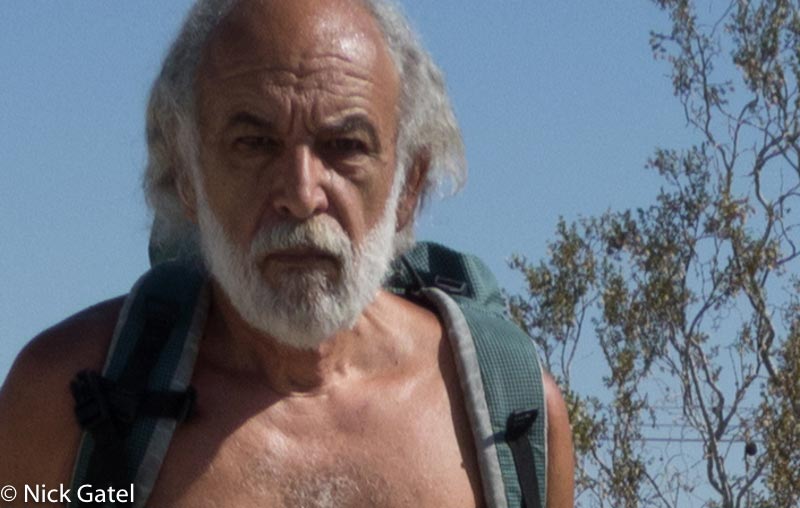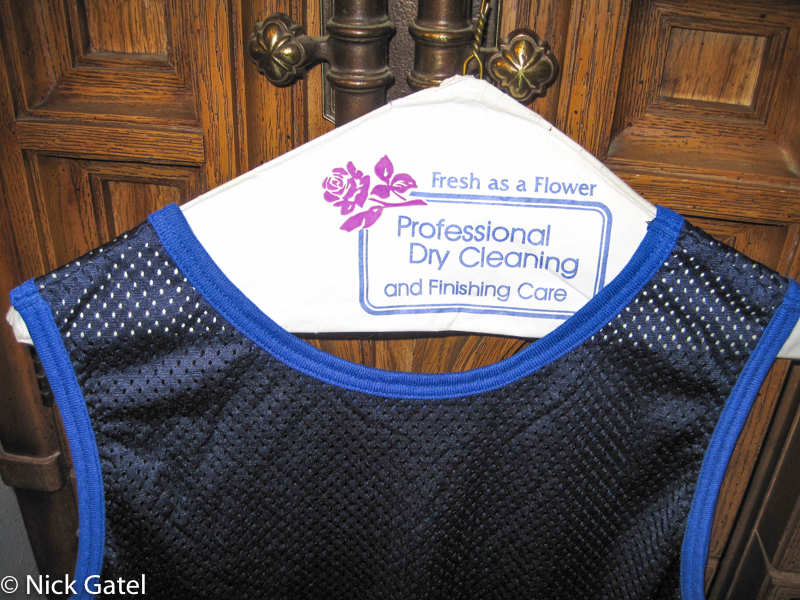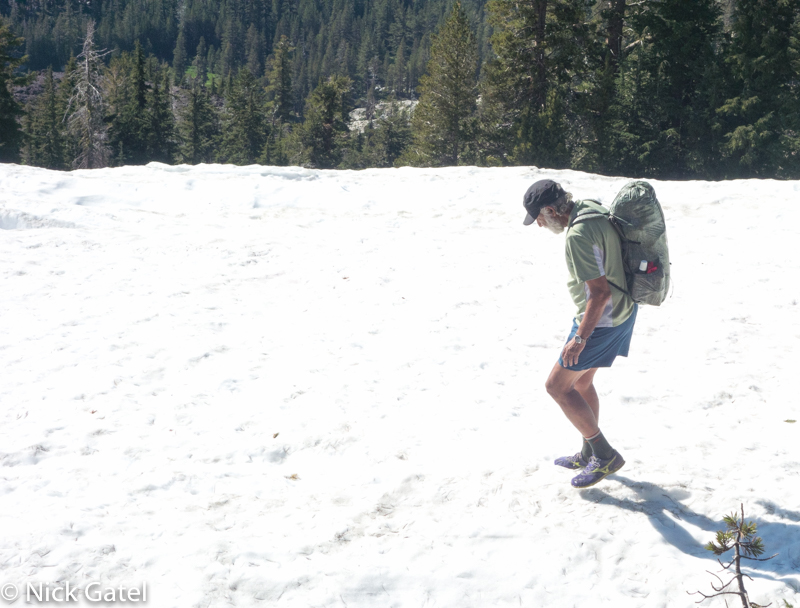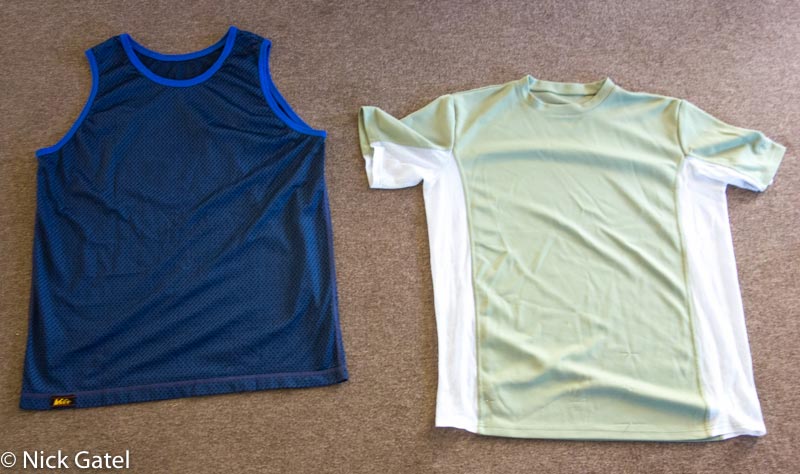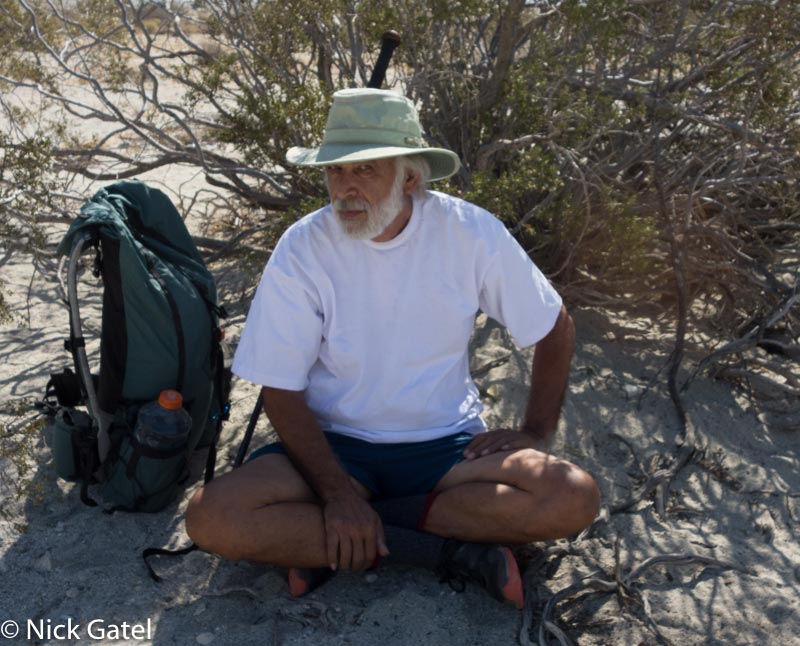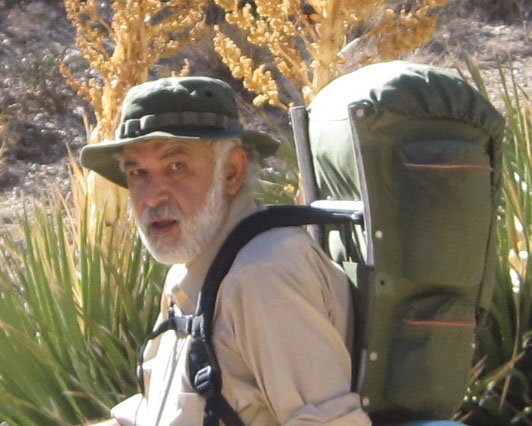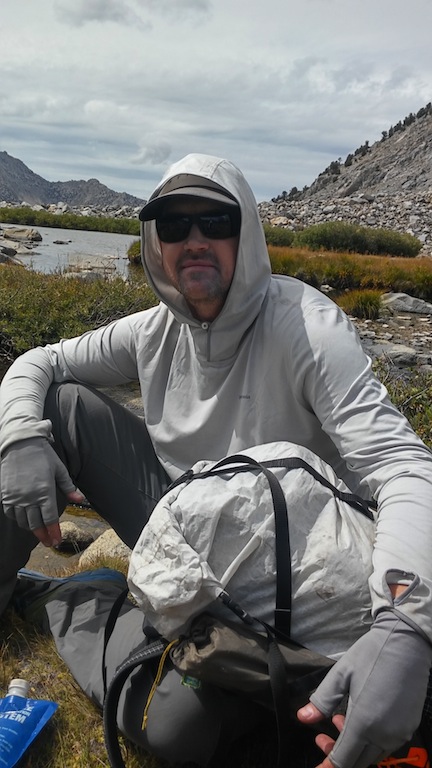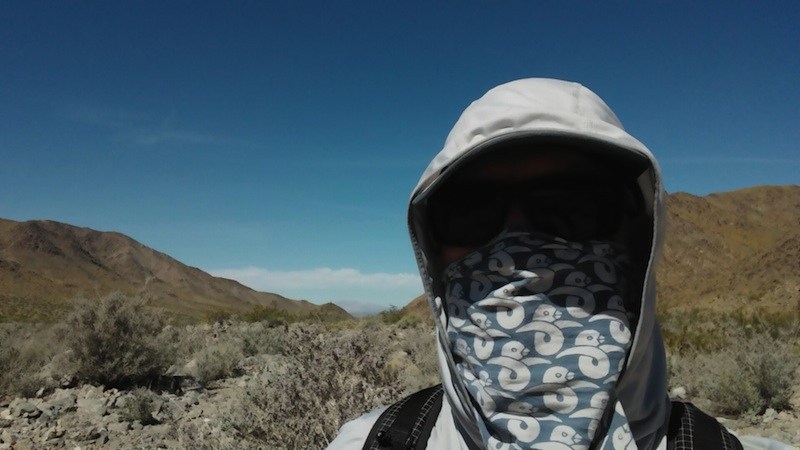Topic
Maximizing cool clothing strategy for hot, dry, sunny desert?
Forum Posting
A Membership is required to post in the forums. Login or become a member to post in the member forums!
Home › Forums › Gear Forums › Gear (General) › Maximizing cool clothing strategy for hot, dry, sunny desert?
- This topic has 63 replies, 11 voices, and was last updated 7 years, 5 months ago by
Anonymous.
-
AuthorPosts
-
Aug 11, 2017 at 10:45 pm #3484446
I recommend that people do not hike when it is hot in the desert unless they are well acclimated, experienced in desert hiking, and know how much water they need each day in this kind of weather. Running out of water is extremely dangerous because you quickly deteriorate mentally and can make poor decisions, even if your next water source is just a couple miles away. Most years we have several people who die hiking where I live. You don’t want to mess around with trying to minimize how much water to carry.
There is no clothing strategy that will enable one to significantly reduce the water requirements each day. I seem to need the same amount of water no matter what clothing I wear, or if I hike without a shirt and only wear shorts, shoes and socks.The only good strategy is not to hike in the heat of the day.
We also need to acknowledge that people have different physiologies. I have noticed that people I see (rarely) hiking in remote desert areas in summer all have skinny wiry bodies, to include the occasional solitary miner I used to see years ago. Don’t know if that makes a difference, but I suspect it does.
I’d like to be dressed right so I’d both minimize heat gain and sweat less cause I did so more efficiently cooling me when I did, so I could go farther carrying less water reserves.
The only strategy to go farther and carry less water is to hike at night. But if you hike at night there is more chance of a mishap. Also you won’t be able to sleep much during the day, it’s too hot. And if you think about it, at what temperature does it become difficult to sleep well at night? I’d guess most people start to have difficulty when it is 85F or higher.
Let’s take a look at the last 24 hours where I live, where yesterday and today the high is 110F.
- 5pm 110F
- 6pm 108F
- 7pm 106F
- 8pm 102F
- 9pm 99F
- 10pm 94F
- 11pm 93F
- 12am 91F
- 1am 89F
- 2am 89F
- 3am 87F
- 4am 87F
- 5am 85F
- 6am 85F
- 7am 86F
- 8am 89F
- 9am 91F
- 10am 95F
- 11am 98F
- 12pm 101F
- 1pm 104F
- 2pm 106F
- 3pm 108F
- 4pm 109F
- 5pm 110F
I live in a “low” desert which often is described as under 3,000′ elevation. In summer temperature differentials from low to high usually run 20-25 degrees F. In high deserts it is usually 25-30 F degrees in summer.
If you start hiking at 6am and hike until 11am (5 hours) the temp will rise from 85F to 98F. Now you rest until 7pm. Even though it is 106F, it is quite pleasant to walk because the sun is low on the horizon — not much sunlight hitting your body. Also it is common to get a slight breeze in the late afternoon. If you hike for 5 more hours until midnight, you will have walked for 10 hours, plus the temp is beginning to dip into the 80’s when it will be easiest to sleep. However, I couldn’t sit around for 8 hours during the day. When it’s really hot I will rest from around 1pm – 5pm and then hike until it gets dark.
Official temperature readings are taken 5 feet above the ground and in the shade. If you go out into 105F temps in the sun with an infrared thermometer and start measuring things you will get readings 125F and higher. So you want to avoid hiking in the “heat of the day” because this is the kind of heat you are faced with.
Another thing, don’t assume hot deserts have low humidity. The norm where I live is very dry, but last week we had a couple days where the highs hovered around 115F and humidity was over 50%. That kind of weather is awful for me.
When you are outdoors during the day, in the temperatures I posted above, you will sweat constantly even if you are just sitting in the shade. You will always feel hot. You can’t avoid it, but you can get used to it and learn to ignore it.
Some thoughts on clothing…

I am coolest when I don’t wear a shirt and wear thin, wicking, running shorts. I can work outdoors all day long in 115F temps wearing only shorts and flip-flops. I have a dark complexion and spend most of the hot part of the year at home outdoors with this uniform. When it gets above 115F, I usually wear a white cotton T-shirt — this is the point where a shirt feels cooler for me. And remember, you aren’t going to reduce you water needs much by wearing specialized clothing. You might as well work on being as comfortable as possible.
Colors: If dark colors absorb heat from the sun, they probably absorb heat from your body; if light colors reflect the sun, they probably reflect internal heat back to your body — so maybe colors balance out. I find there isn’t much difference in colors. Light colors might be a little cooler, but I can’t confirm that.
When I hike in the heat I wear the shortest running shorts I can find that have pockets. They are made from ultra-thin wicking material. I always cut out the liners. I want to minimize moisture because in these kinds of conditions “jock itch,” which is a fungal growth, can be a concern. Being skinny I don’t get any kind of chaffing from my thighs rubbing or anything like that.
If I wear a shirt, it is just because it is more comfortable under a pack vs. no shirt, and I wear loose fitting shirts. My size is medium and my hiking shirts are large or extra large. For years I wore a mesh shirt from REI. I had many pairs, some with sleeves, some without. I am down to my last shirt, since all companies discontinue good products <sigh>.

It is made from some sort of polyester material. You can buy similar shirts in the basketball section of a sporting goods store.
Nowadays I mostly wear a Rail Riders Eco Speed T-shirt. It has mesh side panels. The rest is some sort of polyester, large weave and fairly thick for a T-shirt. I also usually wear it much cooler weather. It works well, and since it works well Rail Riders discontinued it.

I may be on snow, but the temp was around 85F.

Left: REI Mesh Shirt, Right: Rail Riders Eco Speed Shirt
Sometimes I wear a cotton T-shirt. And a thick one, probably 6 oz per yard. It is an extra large. But it gets dirty really fast. If daytime temps get over 115, I usually wear one of these cotton shirts. I buy them by the dozen; they are usually my urban wear too.

In my opinion, the most important piece of clothing is a wide brimmed, ventilated, high crown hat. I wouldn’t go hiking in the desert when temps go over 100F without one. The one in the picture is a Tilley Airflo hat. I have a couple of them. Other than that, most of the time I wear a light baseball cap hiking.
Keep in mind that I can work outdoors all day in extreme heat. The downside is I do really poorly in cold weather. On snow trips I have to bring more insulation and a heavier sleeping bag than most people. That being said, most people who hike in hot deserts should have a strategy to protect them from sunburn and possible skin cancer. Two strategies would be full clothing or sunblock. Since I usually have a good tan, sunburn isn’t an issue. I find that sunblock makes me feel hotter. Not sure if the lotion gets heated by the sun or it blocks my pores. Sunblock doesn’t bother me on my legs, so that isn’t an issue. But for my torso and arms it is. A cotton/poly (60/40 or similar) long sleeve shirt works well in heat. I have some Rail Riders Eco-Mesh and Adventure shirts. Another good choice, although they are made from some sort of polyester or nylon — no cotton. I prefer the cotton/poly.

Years ago I experimented with a light cotton undershirt with a long sleeve cotton poly shirt. Didn’t make a difference with or without the undershirt.
If you need to wear long pants, cotton underwear is no good. You need wicking underwear. Ex-Officio Give-and-Go briefs are the best I have found. You don’t want to waste water in the desert, but washing the nether regions between your legs each night is a good idea when wearing underwear and pants. With my running shorts I don’t have to worry about it.
The last thing, and very important, is dealing with all the salt and minerals you lose through perspiration. They have to be replaced. If you don’t, you can get very sick and you can get sick quickly. I find sports drinks don’t “quench” my thirst like plain water does. So I drink plain water. You need to replace the salt. Many desert hikers use salt tablets. Although I generally have a cast-iron stomach, salt tablets upset my stomach. Potato chips, and other salty foods immediately perk me up when I go into a salt-deficient bonk. Pringles are highly recommended.
Aug 12, 2017 at 12:57 am #3484451Good post Nick although I need a different clothing strategy myself it’s mainly to do with minimising the risk of melanomas and I feel cooler with full body covering of loose open weave fabrics
One thing you haven’t mentioned which is pertinent. Even when fully aclcimatised it isn’t possible to rehydrate at the same rate as water can be lost through sweating or through respiration
When I was running while living in the Alice we used to weigh ourselves before and after our training runs of about 5 to 8 kilometres. Sometimes because of shift schedules running in the heat of the day was unavoidable if we were desperate to train [ runners get addicted to running after all]
In two hours it was common to lose 4 to 6 kilos and it would take the rest of the day to rehydrate fully but we did try not to run when the air temperature was above 42C.
I did run one day when it was 45C, and I suffered for it, heat stroke and 3 days off work with cramps and vomiting, if that had been a walk away from help I would have been dead on day 2
There is a general rule of thumb for fire risk that is appropriate to approximate for walking/running, for every degree Celsius above 38 degrees the risk doubles
Aug 12, 2017 at 7:56 am #3484467Running vs. walking. I would guess a runner burns 3 times as many calories per miles and needs more water. If I hike all day in the mountains with a high of 85F and lots of trees I’ll drink a liter of water, maybe less. In the desert hiking all day with a high of 105F, I need one gallon. Hiking in 115F, with a 3 or 4 hour mid day rest, I need closer to 2 gallons. If I’m outdoors all day working outdoors, which isn’t as strenuous as backpacking, I drink a couple gallons of water in 115F weather.
Even if one gets mildly dehydrated, it isn’t a mater of drinking some water to recover, it takes time and rest to completely get back to normal.
I’ve never been seriously dehydrated except for one time. My 2nd year in the desert I played golf with a friend in the middle of summer. The golf course was almost empty because of the heat and greens fees were cheap in summer. We decided to play 72 holes. We had a golf cart, so we were in the shade a lot. Thinking beer was mostly water, I drank 6 beers and a little bit of water (hey, I was 26 years old, in great shape, and invincible). Got deathly ill not knowing the effects of alcohol contributing to dehydration.
Aug 12, 2017 at 8:27 am #3484477+1 on a great post Nick. In the desert I am a shorts and long sleeve Rail Riders shirt person. Bone Flats right now.
Aug 12, 2017 at 12:06 pm #3484511Great detailed post, Nick, re-reading again now, thank you.
Googling up the arab long flowing robes, too, out of curiosity, for how that seems to work out for them. Thinking it keeps evaporated cooler air nearer skin longer as it surges around underneath from movement and harsh hot winds can’t whisk it away so quick. I can see where it’d be best in very low humidity, as my clothing, other than under belt or lower back with pack, is, for me, never damp, much less wet, from sweat, as it evaporates away instantly, especially if any breeze.
EMS friend in West Texas BB area told me most of the tourists who get into trouble for lack of drinking enough water, even when they had plenty on hand, was cause they were used to back home that their sweaty wet garments being their cue that they probably needed to drink more and thus they didn’t see their dehydration creeping up on them out there. For me, if i’m not peeing plenty at least every two hours, I’m drinking more.
Aug 12, 2017 at 12:41 pm #3484514If you research Bedouin clothing you’ll find the clothing the outer garmet is pretty thick wool, plus they’re acclimated to the climate.Aug 12, 2017 at 1:20 pm #3484518Anonymous
InactiveNice overall post Nick. Some brief points/clarifications:
“Colors: If dark colors absorb heat from the sun, they probably absorb heat from your body; if light colors reflect the sun, they probably reflect internal heat back to your body — so maybe colors balance out. I find there isn’t much difference in colors. Light colors might be a little cooler, but I can’t confirm that.”
It’s not quite so simple. There is a range of IR and what the body emits and what the Sun emits are at different ends of the spectrum that is IR*. There isn’t really noticeable human IR reflection or absorption with different colors, whether black or white. In this case, the material itself is a more important. Polyethylene and microfiber nylon for example, pass human IR radiation very well and efficiently (more “invisible” to human IR radiation). Polyester not so well–reflects it more. Thinness and thickness also matter.
But even then, these are pretty minor differences and probably not that noticeable by the average person.
Perhaps one exception I have noticed is uhmwpe clothing. I have some protective arm sleeves made out of this material. Due to a combo of different properties, it feels very cool on the skin. The material itself is unusually conductive–relatively close to that of water. The yarns and fibers used are large, thick ones so they don’t still/trap much air, it’s very air porous, and the material passes IR fairly well–though in that area it would be much more efficient if the yarns and fibers were much smaller/thinner.
Regarding wearing very dark vs very light colors in the Sun–I personally notice a pretty big difference, especially the thinner the material.
* I was first clued into this when I talked about using some aluminiumized cuben as an IR reflective vapor barrier for extreme cold weather backpacking. Richard Nisley, kindly corrected me and pointed out that because there is a thinnish mylar film over the aluminum, it doesn’t reflect human IR range very well, but would probably still reflect Solar just fine. These highly reflective of human IR radiation materials apparently need some air space to work most efficiently (which is something that Jerry has been saying for awhile here, and Richard has proved with tests).
Aug 12, 2017 at 1:33 pm #3484520Yes, Nick, that’s another thing I was puzzling about, the thick wool outer garment.
Wearing anything insulating seems counter intuitive, but if truly good unrestricted air circulation underneath is still providing maximum evaporative cooling, then insulation atop that, that does not hinder that cooling, might make sense.
If outside hot air, especially if blowing, is anything hotter than evaporative cooled air inside close to skin, that cooler internal micro environment has less conductive and convective heat intrusion trying to heat it up, yes?
Another, and maybe primary for them, reason they utilize it, is that same thick wool garment needs to keep them warm during cooler desert nights, no puffy in their pocket.
Aug 12, 2017 at 2:25 pm #3484526yeah, theoretically, if it’s warmer than body temp, then insulation would actually be a help, except it’s never going to be much warmer than body temperature so this is minor
the main thing is evaporative cooling. Wool would absorb water so it could then evaporate
wool is handy for Bedouins, they don’t have synthetics
for us lightweight backpackers, synthetic is lighter weight and available
better to have long sleeves, pants, and hat to protect from sun exposure. Those old timer desert white guys always had wrinkled skin. Would have died from skin cancer, except they died of other causes first.
Aug 12, 2017 at 2:27 pm #3484527if you didn’t mind looking like a Bedouin, i bet a robe made of white synthetic would work really good
Aug 12, 2017 at 2:30 pm #3484528
I think a baggy shirt and pants would work pretty similar
Aug 12, 2017 at 3:23 pm #3484535Anonymous
InactiveThat’s sort of what I do when I’ve spent time there, and again, primarily with the 55% linen to 45% cotton blends.
But I think my first, more hypothetical idea would work better (provided there’s not a strong, hot wind) than that guys get up.
Cotton spandex blend, somewhat form fitting “baselayer”, and then draped over, stiff fabric, light colored linen or ramie partial poncho.
Wet fabrics become a lot more conductive than when they are dry. Cotton in particular, loses it’s twisty ribbon shape, and gets both flat and spongy when wet. It both loses air space when wet, and you have more of the conductive fabric touching your skin at this point. Combined that with it absorbs a fair amount of moisture directly, and doesn’t give it up quickly, is what makes it really bad for cool and wet or cold conditions. Spandex seems to absorb a lot of moisture. It probably gives it up faster than cotton, but I’m not sure on this.
The reason why spandex absorbs so much moisture is because of all the micro fibrillation that goes on–more surface area and space for water to be held.
Many BPL folks might be familiar with Richard Nisley’s charts of dry times of different fabrics/materials and that the key, or predominant factor was less the specific material and more the thickness and weave of the garment in question. Thicker, knit fabrics in particular had more space for water to occupy and so tended to take longer to dry.
I’d might use, say thicker cotton because of that, but unless you’re in a somewhat more humid part of a desert, then you never really get wet enough most of the time to take full advantage of cottons absorbent and slow drying nature (and it’s very conductive properties when it becomes very wet). So a more thinnish cotton, baselayer type garment, in combo with an outer poncho like garment, would probably work best. Now if you had occasional access to outside water not used for drinking, then an ultra thick cotton shirt (let’s makes it sweater) soaked would be quite nice!
I suppose you could always pee on your shirt too…
Aug 12, 2017 at 3:36 pm #3484537I like the Patagonia Tropic Comfort Hoody II paired with a cap, pants (been using Patagonia Rock Craft/Buttress), generously sized sunglasses, sun gloves, and a bandana if it’s really bad. All of the above breathe well enough for my taste. Keep in mind that this is coming from someone that surfs, loves hiking in the desert in all temps, and has had two basal cell carcinomas removed with more to come (Father Odin’s way of telling Vikings they shouldn’t live in deserts. Oh well).
Sun protection, sun protection, sun protection. I can deal with heat.

 Aug 12, 2017 at 3:43 pm #3484538
Aug 12, 2017 at 3:43 pm #3484538Anonymous
InactiveWhat the hey Zeus is on your bandanna there Craig?! It looks like weird duckling serpent hybrids…
Aug 12, 2017 at 3:56 pm #3484539Ha…yeah, bird serpents or something of the like. It’s a tenugui I picked up in Japan nearly 20 years ago, my favorite ever.
Aug 12, 2017 at 4:01 pm #3484541Justin, rather than pee (which camels purposely pee on themselves for cooling effect), there’s up to 1.5 liters per day just from respiration, in dry desert, when you exhale that you might could use. One way is to use it moisturize that incoming dry air, so lungs don’t have to impart and lose so much to it, thus reducing your need to replenish water as much, might be similar to masks used in extreme dry cold, like coldavenger.com or that some flyers use on long flights cause of the very low cabin humidity, such as humidiflyer.com.
Additionally, what moisture is not recirculated in your exhalation might be helpful if it finally exhausts and exits out around neck, to finally evaporate & cool there before being lost for good. Temperature of breath should always be less than 100F plus desert air, too, so it helps cool for that difference, too.
Then, finally, if whatever garment you have, if it’s moist evaporation exhaust from body perspiration is vented topside around neck it’ll add to that neck cooling effect, plus to cool and/or moisturize your inhalation air if drawn in from there, it further reduces lungs having to give up so much moisture, too. Don’t know how foul smelling that’d be or not.
Aug 12, 2017 at 4:21 pm #3484548My sleeves are long enough that it totally covers my hands. Velcro strips so I can tighten around wrist when I need to use hands.
Okay for walking, not so good if I have to use my hands like for climbing
Next, what can we learn from Dune?
(Okay, that’s sci fi so probably not relevant but there are a lot of sci fi things relevant in other areas)
Aug 12, 2017 at 4:26 pm #3484549“I suppose you could always pee on your shirt too…”
Had another thought, Justin, my feet get really hot in desert, love to be able to cool them down. What if you had lightweight cotton washcloths pinned over atop your shoes, kinda like short gaiters, and pissed on them every time you stopped for a leak? Just enough material so you didn’t soak through and ruin your shoes, do you think that’d be worth any cooling effect?
Aug 12, 2017 at 8:32 pm #3484597I think we need to define HOT here. Hot to me is any temperature above normal body skin temperature. So from 35C and up. 25C to 30C is Warm and where clothing is optional
Aug 12, 2017 at 9:16 pm #3484605Edward, I’d agree with that, for low humidity, but as it goes up, my HOT then is at an ever lessor temp.
Aug 12, 2017 at 10:13 pm #3484612Deserts are almost never humid tho and the OP was about deserts
Humid jungle is a whole new bowl of anchovies and I don’t go there if I can help it.
25C and 99% humidity is a PITA where I am concerned.
Aug 13, 2017 at 4:33 am #3484630Between 35 c and 40 C is ‘hot’, and it’s worse when the humidity is over 80%. Sadly, we get that here quite a bit. Our standard loose Taslan clothing and big hats.
We crawled out of some serious country one day without water, went to the small town nearby and indulged in ye olde world milkbar. The lady there commented that her husband told her it was still 40 C in the barn at 7 pm.
Cheers
Aug 13, 2017 at 7:10 am #3484639Dry saunas: 90c & 15%rh max
“Wet” saunas: 45c & 100%rh
Anytime a person is discussing temperature, it would be great to discuss humidity as well. Even deserts experience big humidity swings (especially right before a storm), and just a few percent change in humidity at 40c will feel a LOT different. I’ve never been on a trip where I don’t have a good wicking towel In my kit – winter or summer.
Aug 13, 2017 at 7:27 am #348464180 F is hot, when I’m hiking in the sun : )
30 C for you people in the developed world
Aug 13, 2017 at 8:54 am #3484652This was mid afternoon at 95 degrees (35 C) or more with no breeze, hot as hell. We were headed for the truck so kept on going instead of settling into some shade. Big Bend

-
AuthorPosts
- You must be logged in to reply to this topic.
Forum Posting
A Membership is required to post in the forums. Login or become a member to post in the member forums!
Our Community Posts are Moderated
Backpacking Light community posts are moderated and here to foster helpful and positive discussions about lightweight backpacking. Please be mindful of our values and boundaries and review our Community Guidelines prior to posting.
Get the Newsletter
Gear Research & Discovery Tools
- Browse our curated Gear Shop
- See the latest Gear Deals and Sales
- Our Recommendations
- Search for Gear on Sale with the Gear Finder
- Used Gear Swap
- Member Gear Reviews and BPL Gear Review Articles
- Browse by Gear Type or Brand.

